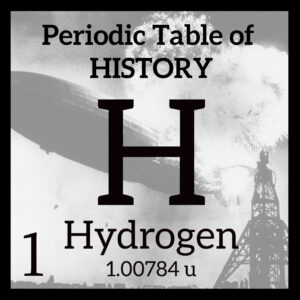Raise your hand if you’ve heard of the Hindenburg disaster. You know, where the largest dirigible ever built, the pride of Nazi Germany and filled with the lighter than air hydrogen (H) gas, burst into flame attempting to land on its transatlantic voyage to the United States? The one that killed 36 passengers and crew? Put your hand down and gather ‘round, because I want to tell you a story about one of the crew members who perished. The only one who was actually on the ground. So let’s travel back to Lakehurst, New Jersey, on May 6th, 1937 (1).
Allen Orlando Hagaman (2), a 51-year-old civilian working for the Zeppelin Company, kisses his wife Anna goodbye on his way to a job—guide-line holder for landing dirigibles—that pays him the princely sum of $1 a day. We may laugh at that paycheck now, but this was the middle of the Great Depression and, according to my dad (who lived through the Great Depression and used to walk to school in the snow uphill both ways past a haunted house, WOW), that dollar could buy a CAR. Kidding. It’s worth about $20 today (3).
Wind and rain delay the Hindenburg’s landing, but at 7:21 p.m., everyone is in place. Cameras have been set up to film the event, and journalist Herb Morrison is on hand to record the famous second by second commentary (4). Hagaman is assigned to the aft section, directly under the tail of the airship. Engines humming, the Hindenburg descends with measured control, ground lines slithering down to be anchored—a choreographed dance of man and machine. Imagine his awe as he looks straight up at the massive silver Zeppelin framed by a darkening sky.
A sudden blinding glow lights the air above. “Something’s wrong!” shouts Hagaman (5). The Hindenburg roils with fire and an intense blast of heat envelopes the men on the ground. They run for their lives as white balls of flame surge higher and crushing aluminum girders (6) plummet to earth. Hagaman trips and falls. He struggles to rise.
But it’s too late. In just 34 seconds (7), the entire ship incinerates and blankets him and the ground as the hydrogen that once held it aloft is consumed in the conflagration.
Rescuers brave the flames and pull him from the wreckage. They rush him to doctor. He’s suffered third degree burns over most of his body but is still conscious. It was said he recognized his family as they arrived at his bedside. At 10:30 that night, surrounded by his wife and daughter, Allen Orlando Hagaman died (2). And with the Hindenburg and Hagaman’s life went the era of the airship.
For such a seemingly simple element (#1 on the periodic table, with a molecular weight of 1), hydrogen (H) has surely caused disaster (8), death (9), destruction (10). But it also powers our sun and is one BIG reason for life on earth (11). Which goes to show you: there is always more than one side to every issue, so be sure you walk in another person’s shoes before you make judgements. Preachy, I know, but next time will be about silver (Ag) bullets and French werewolves, which will make up for it. Cross my heart and hope to— Wait.
- https://www.history.com/news/the-hindenburg-disaster-9-surprising-facts
- http://projektlz129.blogspot.com/2014/05/allen-orlando-hagaman-1885-1937.html
- https://www.in2013dollars.com/us/inflation/1937?amount=1
- https://www.archives.gov/exhibits/eyewitness/html.php?section=5
- https://hindenburg.fandom.com/wiki/Allen_Hagaman
- https://artsandculture.google.com/asset/partial-reconstruction-hindenburg-lz-129-aluminium-girders-ludwig-dürr-luftschiffbau-zeppelin-gmbh-friedrichhafen/0wGCH-y8k8OF1w?hl=en
- https://www.businessinsider.com/how-the-hindenburg-changed-aviation-history-photos-2013-5#crucially-the-airship-was-filled-with-flammable-hydrogen-rather-than-the-safer-helium-as-the-gas-was-easier-for-germany-to-get-ahold-of-11
- https://www.sciencedirect.com/topics/engineering/hydrogen-explosion
- https://www.sciencedaily.com/releases/2016/06/160616105904.htm
- https://www.atomicarchive.com/history/cold-war/page-4.html
- https://www.space.com/17170-what-is-the-sun-made-of.html



 Lithium and Periodic Table of HEALTH
Lithium and Periodic Table of HEALTH
Leave a Reply